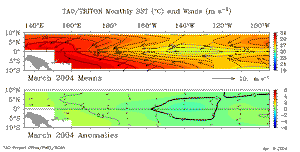 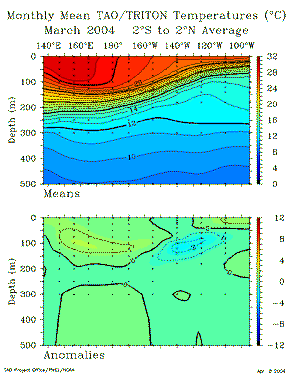
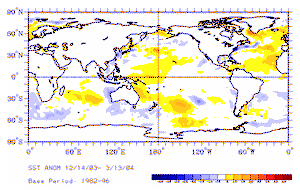
|
Sea-Surface Temperatures (SSTs)
and
Mixed-Layer Conditions: SSTs decreased across the
central and eastern equatorial Pacific in
March. The observed SST anomalies remained slightly above
normal in the central equatorial Pacific, and slightly below normal
in the western equatorial Pacific, which were reflected by
decreases in the monthly averaged Niño 3.4 and Niño 4
indices (map of
Niño regions). For the latest oceanic temperature
conditions, please see the loop of satellite images of March
weekly SST anomalies. The decreases in SSTs in the Niño 3.4 and Niño 4 regions (map of Niño regions) were evident in the data from NCDC's Extended Reconstructed Sea Surface Temperature (ERSST) dataset. March was the ninth consecutive month where the observed SST anomaly in the Niño 3.4 region was above average for the central Pacific. Although slightly warmer than average for the month, the Niño 3.4 anomaly cooled to +0.07°C (+0.126°F) above normal, while the 3-month running mean cooled as well (+0.19°C; +0.35°F), which continued a trend toward neutral SST conditions that began in December 2003. A running 3-month mean SST anomaly above +0.5°C in the Niño 3.4 region is one indicator that an El Niño warm event is occurring. (For the official NOAA classification scheme, please see NOAA's El Niño/La Niña Index Definition and see the CPC ENSO Diagnostic Discussion for their latest official assessment of ENSO conditions). Sub-surface temperatures also cooled across the central and eastern Pacific region in March. Positive sub-surface temperature anomalies that were present at the beginning of March began to cool during the month, with below normal temperatures developing in the mixed-layer and spreading eastward. These below normal temperature anomalies propagated quickly eastward during March, and were centered at approximately at 130°W by the end of the month. This eastward movement was evident in the loop of March sub-surface ocean temperatures, and was associated with a strengthening of the near-equatorial easterly trade winds. The cooler surface and sub-surface conditions in the eastern Pacific during March were reflected in a decrease of the monthly average depth of the 20°C isotherm, which is used as an approximate depth of the oceanic thermocline (the oceanic thermocline in the eastern Pacific is anomalously deeper during El Niño episodes, and shallower during La Niña episodes). |
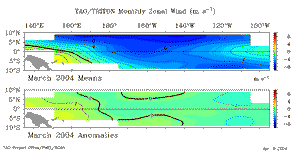
|
Equatorial Zonal Winds (U-Component Wind): In March, the near-equatorial zonal wind anomalies were negative, which reflected the stronger than average easterly trade wind flow across the equatorial Pacific. The anomalously strong trade winds were especially evident during the first part of the month, when several periods of enhanced easterly flow were observed across the basin. This observed increase is clearly shown in the March 5-day averaged zonal winds. These 5-day mean zonal wind speeds illustrate high-frequency fluctuations in the strength of the trade winds, and the March monthly average composite showed that the stronger than average easterly anomalies were present across the equatorial Pacific to the dateline. |
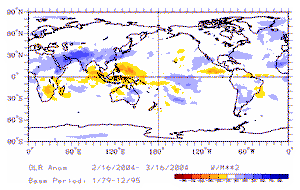
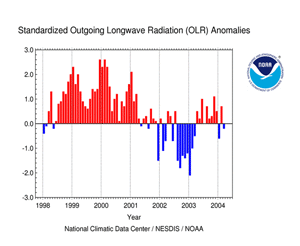
|
Outgoing
Longwave Radiation (OLR): The average OLR index value for March was slightly negative across the region centered between 160°E and 160°W. The negative March anomaly was the third in a series of abrupt shifts that began in January, when the index shifted from a nine-month period of positive values to a negative value for the month. The map to the left for the period 16 February through 16 March clearly shows a widespread area of negative OLR anomalies in the far western Pacific, while positive OLR anomalies were observed over a broad area of the central equatorial Pacific. These OLR anomalies reflected areas of enhanced convection that were present across Indonesia and adjacent areas of the northwestern tropical Pacific, while suppressed convection was present over the equatorial central Pacific. Therefore, the March OLR signal was indicative of near-neutral conditions in the Pacific basin. High frequency variability in OLR is associated with the Madden-Julian Oscillation (MJO) (MJO related convective activity propagates west to east in the near-equatorial region from the Indian Ocean into the Pacific Ocean approximately every 30-60 days). Enhanced convection associated with MJO activity propagated eastward in early-February, and another, albeit weaker, MJO event moved into the basin in late February and early March. Despite the influence of the MJO, deep tropical convection remained over the far western part of the Pacific Basin, and no significant anomalies had developed east of the dateline in March. However, a stronger MJO event did develop at the very end of March in the Indian Ocean, and the associated convection began to move eastward into the western Pacific in early April. The latest MJO activity can be seen in CPC's graphs of Daily MJO Indices. |
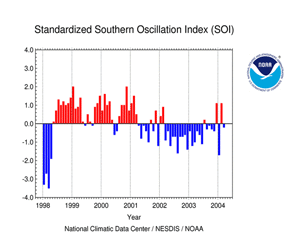
|
Southern Oscillation Index (SOI): For the fourth consecutive month the standardized SOI shifted sign, with a monthly averaged index value of -0.2 for March. Since November, the SOI has switched signs each month, reflecting the lack of any sustained and coherent trend in the mean-sea-level pressure pattern across the Pacific basin associated with ENSO. In-depth monitoring of the SOI and other atmospheric and oceanic indices over the next several months may provide better indications of the evolution of ENSO, since ENSO warm and cold events are often initiated during the latter half of the Northern Hemisphere spring (April-June). The current set of indices, both oceanic and atmospheric, illustrate near-neutral ENSO conditions and no clearly defined shift toward a cold or warm event in the equatorial Pacific basin. However, atmospheric forcing (i.e. westerly wind bursts) associated with past El Niños and La Niñas has developed quickly, and therefore conditions will be monitored closely over the critical late-spring period. |
Additional Links
- ENSO Monitoring
- NOAA El Niño / La Niña Index Definition
- NOAA's Pacific Marine Environmental Laboratory (PMEL):
- NOAA's Climate Prediction Center (CPC):
- NOAA's Physical Science Laboratory
- NASA/JPL Ocean Surface Topography from Space
- Australian Bureau of Meteorology (BoM) Climate Driver Update
- IRI - International Research Institute
 NOAA's National Centers for Environmental Information
NOAA's National Centers for Environmental Information